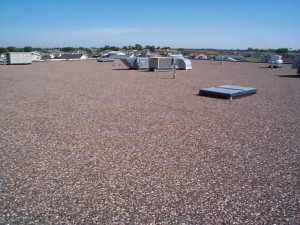HOW TO EVALUATE YOUR OPTIONS AND CHOOSE THE BEST FLAT ROOFING MATERIAL
There are a plethora of flat roofing materials available for use on your building, and it is often overwhelming to try and decide which material is best for your specific situation. We have other posts evaluating many different materials in detail, but this post is focused more on the decision making process than the specific materials. There is not any one answer as to which is the best flat roofing material for all buildings, but there are a series of questions you can ask yourself to determine the best flat roofing material for your building. If you are in the market for a new flat roof, check out these steps to making the right decision and choosing the best flat roofing material for your situation.
Step 1:
The first and most important step in selecting the best flat roofing material is to gain a complete understanding of your building and your roofing system. If you try to make a decision of which flat roofing material will serve your needs the best without knowing your needs, how do you know if you’re making a good decision? Don’t start evaluating your alternatives if you don’t completely know and understand your roofing system.

Step 2:
Consider three crucial factors of all alternatives available: R-Value, Lifespan, and Durability. You will want to make a list of all the flat roofing options available to you, and then evaluate each option according to these three criteria. Once you have evaluated the options, prepare a scorecard for each material and see which one scores the highest.
R-Value
The first factor you should evaluate for each flat roofing material is the R-value that each offers. This is a measurement of “insulation’s ability to resist heat traveling through it. The higher the R-Value the better the thermal performance of the insulation.” The insulating capabilities of your roofing material can save you money on energy bills every month. Some materials are such good insulators and save so much in energy costs that the roofing system actually pays for itself. The R-values of potential roofing systems are an extremely important factor to consider, and are often indicative of the best flat roofing material.
Lifespan
Next, look at the expected lifespan of the alternatives available to you. Don’t invest a large sum of money in a flat roofing material that is expected to deteriorate and need replacement in ten years. Instead, check out which roofing systems can be installed on your roof, and then see which one lasts the longest. Whichever roofing system has the longest lifespan is the best flat roofing material based on this factor. Once you have researched, log the scores on your scorecard and move on to the next factor.
Durability
Finally, you should examine the durability of the roofing system. How is its wind uplift resistance? Can it stand up to hail, heavy snow, or standing water on the roofing system? How does the roofing system in question handle foot traffic? What does the sun, or large temperature swings, do to the roofing system? You need to know the environmental factors in your area, and how each roofing system in question stands up to those factors. Again, work up a durability score for each roofing system and add it to the other scores.

Using Weighted Factors
You may want to use weights for each factor based on which one you feel is more important. The weights you set will help you calculate the overall score. For instance, you may know that your building has a very old AC unit and it isn’t very efficient, perhaps to combat this you want a roof with high R-values, so you place a higher weight on that factor than the other two. The key is to apply the same weights to all roofing systems so that they are all evaluated fairly and consistently.
Step 3:
Analyze the cost of the roofing alternatives that scored highly after your analysis. Don’t let cost be a limiting factor when you are researching different roofing materials. If you rule out systems based on cost, you may rule out an expensive system without knowing that it will pay itself off due to a high R-value. The benefits of some roofing systems will often outweigh the cost, even if that cost is higher than the other systems.
Conclusion
There is no single best flat roofing material in all situations, but it depends on your roofing system, the environment around your building, and what kind of results you want from your roof. However, while there may not be a definite answer, if you follow these three steps and perform thorough evaluations of all roofing systems available to you, we are confident that you will select the best flat roofing material for your building.
You roof is one of the most expensive investments you can make in your building and also one of the longest lasting. If you don’t want to regret your decision two years after your purchase, take the time to do the upfront research. If you have already researched and think you know what the best flat roofing material is, give us a call or leave a comment! We’d love to hear from you.
